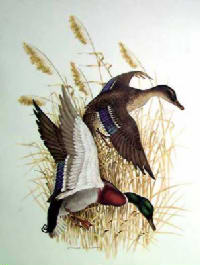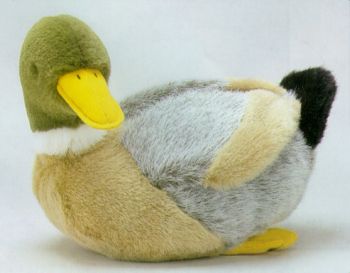Please Help Pets by Donating One Dollar
A young Duck is called a duckling. A male Duck is called a drake,
the female Duck a hen.
Ducks inhabit all continents except Antarctica.
Their legs are generally far apart and toward the rear, making
them awkward walkers but efficient swimmers.
All ducks, except the merganser, have bills lined with bony
notches for straining plant and animal matter from water.
Most ducks of northern continents are migratory. Most males
are bright colored with bold patterns.
Ducks usually nest on the ground.
Ducks vary in their migratory distances. Among American ducks,
the blue-winged teal travels the farthest, nesting in North America
and wintering as far south as Argentina.
Disagreements exist about the classification of ducks, but there
are a number of obvious groups. Most familiar are the surface-feeding
ducks, which include the Mallard
They live primarily on fresh water. The pochards nest on fresh
water but winter on inland lakes and along the coasts. Eiders
and scoters nest in the far north and winter predominantly at sea
Picture Mallard Ducks

Types of Ducks include:
American Black Duck
American Wigeon
Baikal Teal
Black Bellied Whistling Duck
Blue Winged Teal
Bufflehead
Cinnamon Teal
Eurasian Wigeon
Falcated Teal
Fulvous Whistling Duck
Garganey
Green Winged Teal
Mallard
Mottled Duck
Northern Pintail
Northern Shoveler
White Cheeked Pintail
Whistling Ducks
Wood Duck
Bay Ducks include:
Canvasback
Greater Scaup
Lesser Scaup
Redhead
Reing Necked Duck
Sea Ducks include:
Barrow's Goldeneye
Black Scoter
Bufflehead
Common Eider
Common Goldeneye
Harlequin Duck
King Eider
Oldsquaw
Spectacled Eider
Surf Scoter
Steller's Eider
White Winged Scoter
Merganser Ducks include:
Common Merganser
Hooded Merganser
Masked Duck
Red Breasted Merganser
Ruddy Duck
Stiff Tailed Duck
Smew
Picture Merganser Ducks

See Also:
Index of North
American Birds
Magnificent Stuffed Plush Ducks - So Warm and Tender

Delightful Duck Calendars